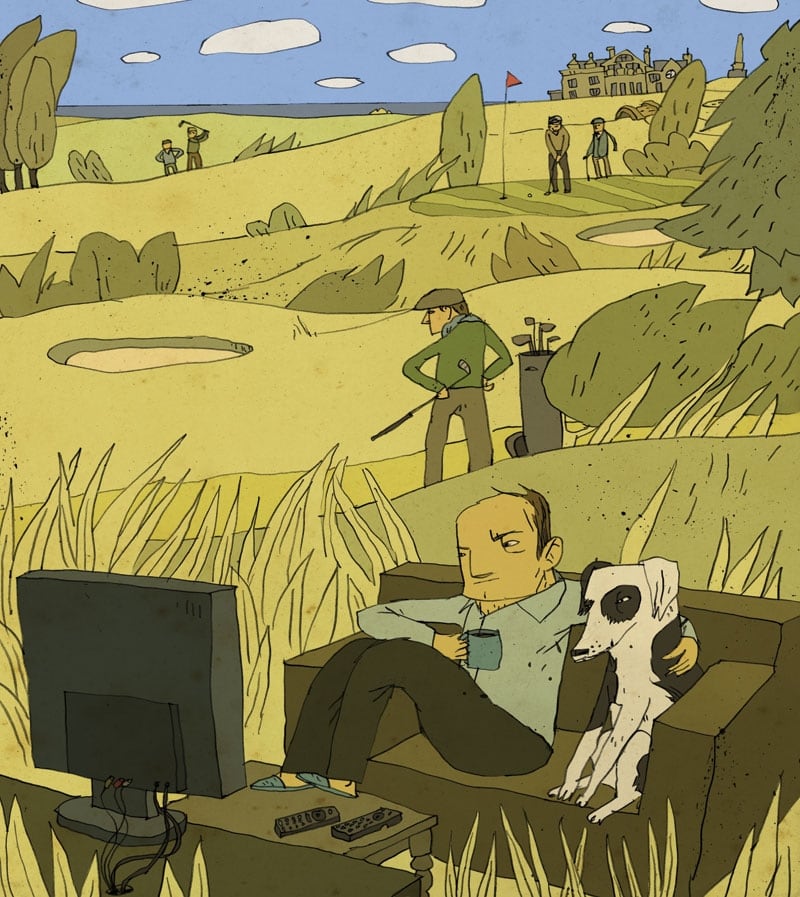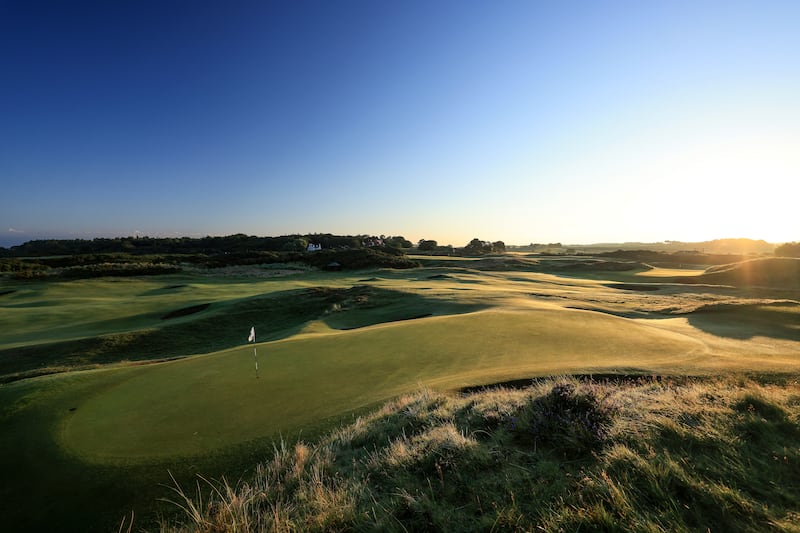At roughly 4am on Thursday in the pre-dawn, darkened silence of my San Antonio, Texas, home, my border collie mix will have given me that befuddled canine glance as I gather him on the couch to renew our glorious July tradition of watching the Open Championship live on the telly.
With the delight of a child expecting Santa, I’ll fire up the obscenely large TV and let the waist-high blond sea grasses of Scotland’s mighty Royal Troon Old Course waft over me like campground wieners. No sight in golf, not Pebble Beach’s crashing surf, nor Augusta’s heaving fairways groomed like a poodle’s butt, quickens my heart like the first televised moments of what most Americans will always call The British Open.
Of course, with DVRs and TV replays, I could watch Thursday’s opening anytime, but there’s something about the quiet dark and the six-hour time difference that makes any Open venue feel distant and mysterious, like David Attenborough traipsing through the Kenyan savanna. The rumpled South Ayrshire links, snugging the Firth of Clyde just 34 miles south of Glasgow and hopefully dried to nearly a melba toast brown, will beckon me as certainly as my first round did on this stunning land. (My ancestor, Alexander Selcraig, a legalised pirate or privateer, was born in 1676 in Lower Largo, Scotland, and after his rescue off the coast of Chile became the inspiration for Daniel Defoe’s Robinson Crusoe.)
Though you likely know this, the Open Championship is completely different from any televised golf tournament we’ll see in the States. If we’re lucky and the angry ocean co-operates, the 152nd Open will not be the genteel croquet match we normally host in Atlanta or Detroit, but a four day wilderness adventure that leaves the champion staggering off the 18th like a viking returning from a seal hunt.
READ MORE
Give me the flagpole halyards clanging in the gales like gunshots and the spectator parents anchoring their children for fear they’ll be sucked into the sea. How does any mortal golfer even sniff par in such brutality? Yet only twice in the tournament’s history have the lords of the Royal & Ancient Golf Club allowed the ferocious winds and rain to cancel play for so long that a Monday finish was required.

What even the grandest quantum dot TV cannot begin to convey, however, is the astonishing quality of light experienced in Scotland’s radiant high latitudes, placing Royal Troon about as far north as Hopedale, Newfoundland. I’ve seen hardened pro photographers all but weep like Sean Connery when describing how their work leaps from the lens over there. I have sat on the stone steps of the Royal & Ancient at St Andrews mesmerised by simply watching the sky above the first hole at the Old Course go from Ibiza blue to seething mountains of coal, then back again. Scotland’s summers are grand theatre.
The luminous storybook towns and their red and green pubs stand in the pristine morning light like new boxes of Crayolas. Freckled kids with names like Tavish and Tyra seem to glow on their way to school. It’s enchanting and half-spooky to those of us trapped in dingy urban air most of the year. When the sun shines in Scotland, it’s like the whole country is broadcast in high definition.
Troon, like many British Open venues, is a true golf village (population 15,000), a metropolis compared to Gullane (population 2,810, next to Muirfield) that might vanish were it not for eons-old dunesland between the ocean and the farms that some genius architect like James Braid or Alister MacKenzie turned into a golf sanctuary a century ago. All that history can make them seem immensely stuffy from afar, but you might be surprised.

On one of my first journeys to Scotland, I teed off at Gullane’s revered championship course, known to locals simply as No 1, and to my dumbfounded glee, a young mother, well within her rights under Scottish law, crossed directly in front of the tee box down a communal path with her pram.
“Splendid day for the golf,” she chirped to our enchanted group of Yanks.
We waved and smiled, giggling at the thought of the SWAT-team response such a trespass would have caused at a private American golf cathedral.
Such scenes are commonplace throughout Scotland and Ireland. Many of the world’s consensus top 10 links courses are not only open to the general public, unlike our Oakmonts and Seminoles, but their trails and dunes are also shared with joggers, surfers and mums on a stroll. That helps to remind us golfers that, technically, we don’t yet own all that we survey.
You’re lucky, golf is more deeply woven into your local culture. You see happy mall-deprived teenagers walking to the courses with golf bags over their shoulders. In Ballybunion, I once stood in a grocery checkout line and listened to two middle aged women fervently discuss their golf grips. Be still my heart. Despite the efforts of barons like Donald Trump, who was intent on Americanising Scottish and Irish golf and installing a valet parking culture, golf remains for most of you an unpretentious game that knows its place.
The tournament itself is, of course, brilliant — from the lilting introductions by the departed and beloved starter, Ivor Robson, to its fabulous rota of links courses and the eternal quirkiness of evil burns and pot bunkers, to the glorious charges and inevitable flameouts of nondescript golfers like France’s Jean van de Velde, who, in 1999 at Carnoustie, had golf immortality in his hands . . . and then tragically unravelled on the 18th hole. And its champions are as likely to be a Louis Oosthuizen (2010, South Africa), Francesco Molinari (2018, Italy) or 5′ 7″ left-hander Brian Harman (2023, USA) as one-named golf heroes like Tiger, Phil and Rory.
I care little about which major has the most worthy pedigree of champions or the finest fields based on the latest world golf analytics. That’s not why I wake before the roosters to watch the British Open. Actually, I think I love this Major the most because it seems to embrace the overlooked golfers who, somehow, on this demanding and unique world stage, find their inner giant and flirt with greatness.
Bruce Selcraig is a former investigative reporter with Sports Illustrated whose work has appeared in The New York Times Magazine, National Geographic and The Atlantic, among others.
- Sign up for push alerts and have the best news, analysis and comment delivered directly to your phone
- Join The Irish Times on WhatsApp and stay up to date
- Listen to our Inside Politics podcast for the best political chat and analysis














